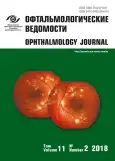Assessment of Corneal subbasal nerve plexus using confocal in vivo microscopy in patients with pseudoexfoliation syndrome after phacoemulsification
- Authors: Potyomkin V.V.1, Varganova T.S.2, Terehova I.V.2, Ageeva E.V.2
-
Affiliations:
- Academician I.P. Pavlov First Saint Petersburg State Medical University
- City hospital No 2
- Issue: Vol 11, No 2 (2018)
- Pages: 13-18
- Section: Articles
- URL: https://journals.rcsi.science/ov/article/view/8932
- DOI: https://doi.org/10.17816/OV11213-18
- ID: 8932
Cite item
Abstract
Phacoemulsification (PE) is the leading method of cataract surgery. Purpose. To assess the impact of PE on corneal subbasal nerve plexus in patients with pseudoexfoliation syndrome (PEX) using confocal in vivo microscopy. Methods. 42 patients (42 eyes) were enrolled in the study. The main group consisted of 24 patients (24 eyes) with PEX syndrome, and 18 patients (18 eyes) without it composed the control group. Confocal in vivo microscopy was performed before and after PHACO. Results. In patients with PEX after PE, an increase in number of nerve branches and pellet-like structures in them were noticed (p < 0,05).
Full Text
##article.viewOnOriginalSite##About the authors
Vitaly V. Potyomkin
Academician I.P. Pavlov First Saint Petersburg State Medical University
Author for correspondence.
Email: potem@inbox.ru
PhD, Assistant Professor. Department of Ophthalmology
Russian Federation, Saint PetersburgTatyana S. Varganova
City hospital No 2
Email: varganova.ts@yandex.ru
PhD, Ophthalmologist
Russian Federation, Saint PetersburgIrina V. Terehova
City hospital No 2
Email: irterehova@yandex.ru
Chief of Ophthalmology Diagnostic Department
Russian Federation, Saint PetersburgElena V. Ageeva
City hospital No 2
Email: ageeva_elena@inbox.ru
Ophthalmologist
Russian Federation, Saint PetersburgReferences
- Бржеский В.В., Егорова Г.Б., Егоров Е.А. Синдром «сухого глаза» и заболевания глазной поверхности. – М., 2016. [Brzheskiy VV, Egorova GB, Egorov EA. Syndrome of “dry eye” and diseases of the ocular surface. Moscow; 2016. (In Russ.)]
- Потёмкин В.В., Варганова Т.С., Акопов Е.Л., Агеева Е.В. Влияние псевдоэксфолиативного синдрома на морфологические свойства роговицы по данным конфокальной in vivo микроскопии // Офтальмологические ведомости. – 2017. – Т. 10. – № 2. – С. 49–55. [Potemkin VV, Varganova TS, Akopov EL, Ageeva EV. The influence of pseudoexfoliative syndrome on corneal morphology based on in vivo confocal microscopy. Ophthalmology journal. 2017;10(2):49-55. (In Russ.)]. doi: 10.17816/OV10249-55.
- Потёмкин В.В., Агеева Е.В. Состояние глазной поверхности при псевдоэксфолиативном синдроме // Учёные записки СПбГМУ им. акад. И.П. Павлова. – 2016. – Т. 23. – № 1. –·С. 47–50. [Potemkin VV, Ageeva EV. Ocular surface condition in patients with pseudoexfoliative syndrome. Uchenye zapiski SPbGMU im. akad. I.P. Pavlova. 2016;23(1):47-50. (In Russ.)]
- Потёмкин В.В., Варганова Т.С., Агеева Е.В. Возможности конфокальной микроскопии при заболеваниях глазной поверхности // Офтальмологические ведомости. – 2017. – Т. 10. – № 1. – С. 23-30. [Potemkin VV, Varganova TS, Ageeva EV. Confocal microscopy in ocular surface disease. Ophthalmo logy journal. 2017;10(1):23-30. (In Russ.)]. doi: 10.17816/OV
- -30.
- Потёмкин В.В., Агеева Е.В. Причины поражения тканей глазной поверхности при псевдоэксфолиативном синдроме // Российский офтальмологический журнал. – 2017. – Т. 10. – № 3. – С. 62–68. [Potemkin VV, Ageeva EV. Causes of ocular surface tissue lesions in patients with pseudoexfoliation syndrome. Rossiiskii oftalmologicheskii zhurnal. 2017;10(3):62-68. (In Russ.)]
- Потёмкин В.В., Варганова Т.С., Терехова И.В., Агеева Е.В. Влияние факоэмульсификации на состояние различных слоёв эпителия роговой оболочки у пациентов с псевдоэксфолиативным синдромом по данным конфокальной микроскопии in vivo // Офтальмологические ведомости. – 2017. – Т. 10. – № 3. – С. 29–34. [Potemkin VV, Varganova TS, Terekhova IV, Ageeva EV. The influence of phacoemulsification on various corneal layers in patients with pseudoexfoliation syndrome assessed with confocal in vivo microscopy. Ophthalmology journal. 2017;10(3):29-34. (In Russ.)]. doi: 10.17816/OV10329-34.
- Benitez-del-Castillo JM, Acosta MC, Wassfi MA, et al. Relation between Corneal Innervation with Confocal Microscopy and Corneal Sensitivity with Noncontact Esthesiometry in Patients with Dry Eye. Invest Ophthalmol Vis Sci. 2007;48(1):173. doi: 10.1167/iovs.06-0127.
- Cetinkaya S, Mestan E, Acir NO, et al. The course of dry eye after phacoemulsification surgery. BMC Ophthalmol. 2015;15:68. doi: 10.1186/s12886-015-0058-3.
- The definition and classification of dry eye disease: report of the Definition and Classification Subcommittee of the International Dry Eye WorkShop (2007). Ocul Surf. 2007;5(2):75-92.
- Kinard KI, Smith AG, Singleton JR, et al. Chronic migraine is associated with reduced corneal nerve fiber density and symptoms of dry eye. Headache. 2015;55(4):543-549. doi: 10.1111/head.12547.
- Kocabeyoğlu S, İrkeç M, Orhan M, Mocan MC. Evaluation of the ocular surface parameters in pseudoexfoliation syndrome and conjunctivochalasis. Turk J Ophthalmol. 2012;42(5):332-335.
- Lumme P, Laatikainen L. Exfoliation syndrome and cataract extraction. Am J Ophthalmol. 1993;116(1):51-55. doi: 10.1016/S0002-9394(14)71743-X.
- Labbé A, Alalwani H, Van Went C, et al. The Relationship between Subbasal Nerve Morphology and Corneal Sensation in Ocular Surface Disease. Invest Ophthalmol Vis Sci. 2012;53(8):4926. doi: 10.1167/iovs.11-8708.
- Marfurt CF, Cox J, Deek S, Dvorscak L. Anatomy of the human corneal innervation. Exp Eye Res. 2010;90(4):478-492. doi: 10.1016/j.exer.2009.12.010.
- Muller LJ, Vrensen GF, Pels L, et al. Architecture of human corneal nerves. Invest Ophthalmol Vis Sci. 1997;38(5):985-994.
- Naumann GOH. Corneal Endothelial Involvement in Pseudoexfoliation Syndrome-Reply. Arch Ophthalmol. 1994;112(3):297. doi: 10.1001/archopht.1994.01090150027003.
- Naumann GOH, Schlötzer-Schrehardt U. Keratopathy in pseudoexfoliation syndrome as a cause of corneal endothelial decompensation. Ophthalmology. 2000;107(6):1111-1124. doi: 10.1016/s0161-6420(00)00087-7.
- Oliveira-Soto L, Efron N. Morphology of Corneal Nerves Using Confocal Microscopy. Cornea. 2001;20(4):374-384. doi: 10.1097/
- -200105000-00008.
- Sahu PK, Das GK, Malik A, Biakthangi L. Dry Eye Following Phacoemulsification Surgery and its Relation to Associated Intraoperative Risk Factors. Middle East Afr J Ophthalmol. 2015;22(4):
- -477. doi: 10.4103/0974-9233.151871.
- Zheng X. New findings for an old disease: morphological studies on pseudoexfoliation syndrome-related keratopathy and binocular asymmetry. Cornea. 2013;32 Suppl 1:S84-90. doi: 10.1097/ICO.0b013e3182a3657d.
Supplementary files













